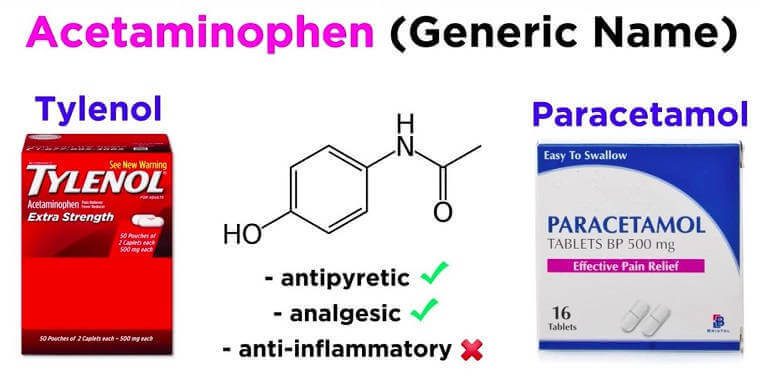Acetaminophen or Paracetamol is one of the most common OTC (Over The Counter) pain relievers that you can find. So common it is that you can find some forms of Acetaminophen at every house, grocery, and pharmacy. From very young children to really old adults can use it. However, just because it is common, doesn’t mean that it is always safe and without side effects. No matter what the medication is, it is important to know about it and be aware of it. In this article, we’ll discuss almost all aspects of Acetaminophen or Paracetamol.
What is Acetaminophen?
It has many names and brands. Tylenol, Paracetamol, Ponstan, Alaxan are just a few examples. It falls under a category of medications known as Analgesic (Pain reliever) And Antipyretic (fever reducer). It was approved by the FDA in 1951.
How does Acetaminophen work?
Acetaminophen works by increasing the pain threshold of our brain. Whenever a person is hurt, a hormone (Neurotransmitter) named Prostaglandin is produced. Prostaglandin signals the brain that there is a cut or damage to a certain part of the body. Our brain then acts to fix that problem. Increasing the pain threshold means that our brain doesn’t react to a small amount of prostaglandin flow. When you take acetaminophen, it requires a lot more prostaglandin than normal before a person starts feeling the pain. That’s why Acetaminophen is only good for low to moderate levels of pain. In severe cases, it would be useless.
Another function of prostaglandin is to stop the blood flow by constricting the vessels surrounding the damaged area. As a result, the area tends to swell. Acetaminophen can’t get rid of the swelling since it allows prostaglandin to flow. Aspirin or Ibuprofen, on the other hand, kills prostaglandin cells and the swelling goes down. Therefore, Aspirin and Ibuprophen are anti-inflammatory while Acetaminophen is not.
Acetaminophen is a lot more effective in cuts as it allows prostaglandin to stop the bleeding (By swelling) and reduces the pain until the damaged area is repaired.
What is Acetaminophen used for?
It is a very common medication for fever and pain. it can be used safely in these situations:
- Cuts
- Bruises
- Headaches
- Toothaches
- Fever
- Body pain caused by flue and cold
- Body pain caused by Osteoarthritis
- Joint pain caused by gout
- Menstrual pains
- Ulcer Pains
Yet, remember that it cannot help if the pain is severe. For that, you would require Opioid Pain Relievers.
Related: Where to Buy Tramadol Online
What are the Dosages and Forms of Acetaminophen?
Since it is used by patients of all ages, the dosages vary from 5 mg to 500mg. There are also 1000 mg dosages available should there be a need for it.
There are also tablets, capsules, and suspensions for children.
How do we take it?
It is generally taken by mouth. If you are taking the tablet or the capsule form, swallow the pills whole with sufficient water. It is a good idea to have some solid food before taking it.
The suspension for children comes in powdered form and may even come with fruity flavors in glass bottles. Mix the appropriate amount of distilled water and shake the bottle well before pouring it into the spoon provided with the bottle. You must always shake the bottle every time before giving it to your child.
Acetaminophen as a combination drug:
Since it does not harm the Prostaglandin cells and allows the brain to repair damages, Acetaminophen can be used in combination with many other medications. it is very common with anti-flu medications, together with Ibuprofen for sports injuries (To bring down the swelling as well), and as step-down pain relievers for severe pain after a major surgery. Examples of step-down relievers are Percocet (10 mg Oxycodone and 325mg acetaminophen) and Watson 853 (10mg hydrocodone and 325mg Acetaminophen). It can also be prescribed together with Valium (Diazepam) for patients with withdrawal symptoms.
Side Effects:
There are virtually no side effects of Acetaminophen unless you are allergic to it or any of the inactive ingredients in the pill. Consult your doctor if you experience any allergic reactions.
If you are into natural remedies, check out our article: 5 Best Natural Pain Revilers
Acetaminophen and Liver Disease:
Although relatively safe, it does pose a slight threat to patients with liver disease. You have to consult a doctor if you have taken Acetaminophen and are experiencing liver pain.
Things to Remember before or While taking
It is relatively safe unless you have liver conditions or if you are allergic to it. It does not stop or reduce swelling. It is not an NSAID (Nonsteroidal Anti-Inflammatory Drug). It is only an analgesic and an antipyretic. You can buy it at any pharmacy or grocery without a prescription and it is good to have some in your medicine cabinet. However, do consult a doctor if Acetaminophen is the right medication for you.
Share this:
- Click to share on X (Opens in new window) X
- Click to share on Facebook (Opens in new window) Facebook
- Click to share on LinkedIn (Opens in new window) LinkedIn
- Click to share on Pinterest (Opens in new window) Pinterest
- Click to share on WhatsApp (Opens in new window) WhatsApp
- Click to share on Tumblr (Opens in new window) Tumblr
- Click to print (Opens in new window) Print

cool
Very helpful